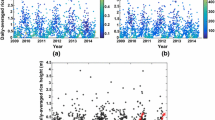Summary
The equation for the turbulent diffusion of water vapour is developed to a form which makes it possible to estimate, in an approximative manner, the amount of dewfall on a short grass surface, or on a bare surface, using routine meteorological data. Introducing data typical for dew nights, the equation leads to estimates amounting to 0.10 to 0.20 mm/dew night. These figures are close to the dewfall amounts measured by the Duvdevani dew gauge at the same stations.
Zusammenfassung
Die Gleichung für die turbulente Diffusion von Wasserdampf wurde in einer Form entwickelt, die die angenäherte Schätzung des Taubetrages auf einer Rasenfläche oder auf einer vegetationslosen Oberfläche unter Benutzung üblicher meteorologischen Daten ermöglicht. Bei Anwendung kennzeichnender Werte für Nächte mit Taufall ergibt die Gleichung Schätzungen, die 0.10 to 0.20 mm pro Taunacht betragen. Diese Werte kommen den Taubeträgen, die mit dem Duvdevanischen Taugerät an denselben Stationen gemessen wurden, sehr nahe.
Résumé
L'équation pour la diffusion turbulente de la vapeur d'eau est développée en une forme qui donne la possibilité d'estimer, d'une manière approximative, la quantité de rosée sur un gazon ou une surface nue, en utilisant des donnes météorologiques de routine. En introduisant des données caractéristiques pour des nuits de rosée, l'équation conduit à des estimations qui arrivent à 0.10 to 0.20 mm par nuit de rosée. Ces valeurs sont proches des quantités mesurées par le jauge de rosée Duvdevani aux mêmes stations.
Similar content being viewed by others
References
Deacon, E. L., Vertical profiles of mean wind in the surface layers of the atmosphere. Geophys. Mem., No. 91, Meteor. Off., London (1953).
Duvdevani, S.: An optical method of dew estimation. Quart. J. Roy. Meteor. Soc.,73, 282–296 (1947).
Frost, R.: Calculation of night minimum temperatures. Prof. Notes, No. 95, Meteor. Off., London (1948).
Gilead, M., U. Mané andY. Katsenelson: Climate in Israel (in Hebrew). isr. Min. Agric., Publication No. 50, Hakirya (1954).
Gilead, M. andN. Rosenan: Ten years of dew observations in Israel. Isr. Expl. J.,4, 120–123 (1954).
Hofmann, G.: Die Thermodynamik der Taubildung. Ber. Deutsch. Wetterd., No. 18, Bad Kissingen (1955).
Jennings, E. C. andJ. L. Monteith: A sensitive recording dew balance. Quart. J. Roy. Meteor. Soc.,80, 222–226 (1954).
Norris, R.: Evaporation from extensive surfaces of water rougened by waves. Quart. J. Roy. Meteor. Soc.,74, 1–12 (1948).
Paeschke, W.: Experimentelle Untersuchungen zum Rauhigkeits- und Stabilitätsproblem in der bodennahen Luftschicht. Beitr. Phys. fr. Atmosph.,24, 163–189 (1937). (This paper was not available for study.)
Pasquill, F.: Eddy diffusion of water vapour and heat near the ground. Proc. Roy. Soc., A198, 116–140 (1949).
Rider, N. E.: Eddy diffusion of momentum, water vapour and heat near the ground. Phil. Trans. Roy. Soc. London, A246, 481–501 (1954).
Rossby, C. G. andR. B. Montgomery: The layer of frictional influence in wind and ocean currents. Pap. phys. Oceanogr. Meteor.,3, No. 3, Cambridge and Woods Hole, Mass., M. I. T and W. H. O. T. (1935).
Author information
Authors and Affiliations
Rights and permissions
About this article
Cite this article
Neumann, J. Estimating the amount of dewfall. Arch. Met. Geoph. Biokl. A. 9, 197–203 (1956). https://doi.org/10.1007/BF02247194
Issue Date:
DOI: https://doi.org/10.1007/BF02247194




